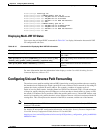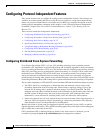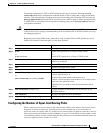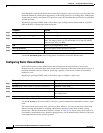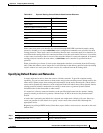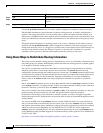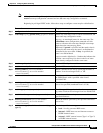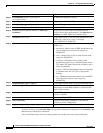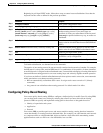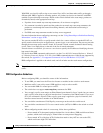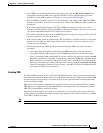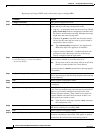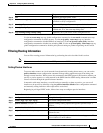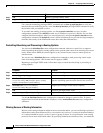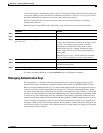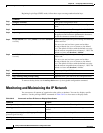
38-83
Catalyst 3750-E and 3560-E Switch Software Configuration Guide
OL-9775-02
Chapter 38 Configuring IP Unicast Routing
Configuring Protocol-Independent Features
Beginning in privileged EXEC mode, follow these steps to control route redistribution. Note that the
keywords are the same as defined in the previous procedure.
To disable redistribution, use the no form of the commands.
The metrics of one routing protocol do not necessarily translate into the metrics of another. For example,
the RIP metric is a hop count, and the IGRP metric is a combination of five qualities. In these situations,
an artificial metric is assigned to the redistributed route. Uncontrolled exchanging of routing information
between different routing protocols can create routing loops and seriously degrade network operation.
If you have not defined a default redistribution metric that replaces metric conversion, some automatic
metric translations occur between routing protocols:
• RIP can automatically redistribute static routes. It assigns static routes a metric of 1 (directly
connected).
• Any protocol can redistribute other routing protocols if a default mode is in effect.
Configuring Policy-Based Routing
You can use policy-based routing (PBR) to configure a defined policy for traffic flows. By using PBR,
you can have more control over routing by reducing the reliance on routes derived from routing
protocols. PBR can specify and implement routing policies that allow or deny paths based on:
• Identity of a particular end system
• Application
• Protocol
You can use PBR to provide equal-access and source-sensitive routing, routing based on interactive
versus batch traffic, or routing based on dedicated links. For example, you could transfer stock records
to a corporate office on a high-bandwidth, high-cost link for a short time while transmitting routine
application data such as e-mail over a low-bandwidth, low-cost link.
Command Purpose
Step 1
configure terminal Enter global configuration mode.
Step 2
router {bgp | rip | ospf | eigrp} Enter router configuration mode.
Step 3
redistribute protocol [process-id] {level-1 | level-1-2 |
level-2} [metric metric-value] [metric-type type-value]
[match internal | external type-value] [tag tag-value]
[route-map map-tag] [weight weight] [subnets]
Redistribute routes from one routing protocol to
another routing protocol. If no route-maps are
specified, all routes are redistributed. If the keyword
route-map is specified with no map-tag, no routes are
distributed.
Step 4
default-metric number Cause the current routing protocol to use the same
metric value for all redistributed routes (BGP, RIP and
OSPF).
Step 5
default-metric bandwidth delay reliability loading mtu Cause the EIGRP routing protocol to use the same
metric value for all non-EIGRP redistributed routes.
Step 6
end Return to privileged EXEC mode.
Step 7
show route-map Display all route maps configured or only the one
specified to verify configuration.
Step 8
copy running-config startup-config (Optional) Save your entries in the configuration file.



